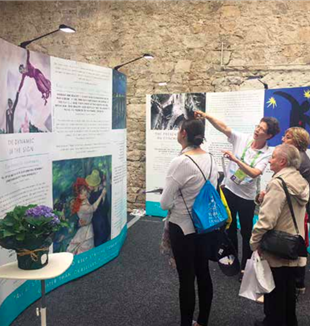
Into the Depths of Who We Truly Are
We publish a letter from one of the guides of "The Love of My Heart," an exhibit presented by the CL community of Dublin at the Royal Dublin Society Conference Centre.I look at the work done to prepare for the Pope’s visit reading Amoris Laetitia, Disarming Beauty by Julián Carrón, and assembling the exhibition as a great gift. When we had the panels physically mounted at the congress, I remember asking whether or not people would actually come and if something new could come out of it.
Then the time of my first guided tour came. I was with two ladies–one I knew (she is the mother of one of my daughter’s schoolmates) and one I didn't from Carlow. I walked with them through the panels, through the journey that we ourselves tried to make, through the points of chapter 13 of Disarming Beauty, and I slowly saw the face of the lady I didn’t know becoming more and more fixed on me, her eyes locked with mine often in what might have been mutual understanding.
I briefly recalled the five points of the exhibition, consisting mostly of how I saw them through my own personal journey and the anthropological crisis we are knee-deep in, the crisis of our relationship with reality when it is reduced to appearances. I was focused on the possibility that our heart is the key to overcoming the crisis, the possibility for each of us to rediscover what holds true, first and foremost by going into the depths of who we truly are. But it was only in front of the panel in which we see the picture of the woman at the well with Jesus that something sparkled … she had five men and none of them understood the thirst that constituted her ... only that Man could claim to be the answer for that thirst for fullness of life.
And the question arose from the woman I didn’t know: “Is it possible for a couple to live this even if it’s only one of the two that sees it?” I told her, “maybe,” and I added that “my life is so much more beautiful when my husband lives his own relationship with God in his own life; then his gaze on me is so different that I can't help desiring to see it every day.”
She thanked me and said, “I came here with a real question for myself and my marriage and even if what I met at the World Meeting of Families was only this it would be enough.” She asked me, “Is there any information I can have about this, where I can read more about it?” I gave her the booklet of the exhibition.
She walked away with the booklet. She came back several hours later, after I had already left, with the booklet in her hand, and told Rita who was still there at the stand: “I read it all and I saw the personal testimonies at the end. I read the one by Chiara … she says that what helped her and her husband through a period of crisis was not a session with a couples counselor but the Spiritual Exercises. What are those Spiritual Exercises? Where are they and when do you do them? Can I come?”
The fact that someone noticed and was interested enough to follow through was sufficient proof for me that we really don’t fully know what we carry, not only for people outside the Christian community, but even among us.
I also gave a tour of the exhibition for a couple and a priest from Sri Lanka in the same group as my mother-in-law. At the end of the exhibition the priest asked several times who Julián Carrón was, what is the title of the book where the things we had on the panels had come from, and how we came across it. The couple and the priest were particularly moved by the last section of the exhibit in which we say that the church is important for the family because it is the place where people can exist in the ambit of a greater love and meet the experience of the fullness of faith … When the tour was over they thanked me “for being for us the witness one of the panels speaks about,” and added, “even your mother-in-law is pleased with you; for us in Sri Lanka this is a difficult and important relationship.”
The priest and the couple returned the next day, and the priest asked me if he could get the book the exhibition is based on. He said he wanted to read it and maybe present it in Sri Lanka. He also left his contact details.
This opportunity ultimately gave me another way to verify what Carrón said to me many years back: “You are here begging for the crumbs that fall from the table even though you are invited to the banquet, but to understand this you need to work.” My own family is a place where He is a presence in my life, so much so that this presence can become meaningful even for others. I hope to live my work and everything else with the same awareness of the relationship with the Mystery I experienced working on the exhibition.
Chiara, Dublin, Ireland